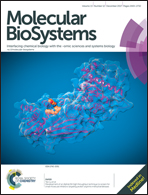Insights into human intrinsically disordered proteins from their gene expression profile†
Abstract
Expression level provides important clues about gene function. Previously, various efforts have been undertaken to profile human genes according to their expression level. Intrinsically disordered proteins (IDPs) do not adopt any rigid conformation under physiological conditions, however, are considered as an important functional class in all domains of life. Based on a human tissue-averaged gene expression level, previous studies showed that IDPs are expressed at a lower level than ordered globular proteins. Here, we examined the gene expression pattern of human ordered and disordered proteins in 32 normal tissues. We noticed that in most of the tissues, ordered and disordered proteins are expressed at a similar level. Moreover, in a number of tissues IDPs were found to be expressed at a higher level than ordered proteins. Rigorous statistical analyses suggested that the lower tissue-averaged gene expression level of IDPs (reported earlier) may be the consequence of their biased gene expression in some specific tissues and higher protein length. When we considered the gene repertory of each tissue we noticed that a number of human tissues (brain, testes, etc.) selectively express a higher fraction of disordered proteins, which help them to maintain higher protein connectivity by forming disordered binding motifs and to sustain their functional specificities. Our results demonstrated that the disordered proteins are indispensable in these tissues for their functional advantages.



 Please wait while we load your content...
Please wait while we load your content...